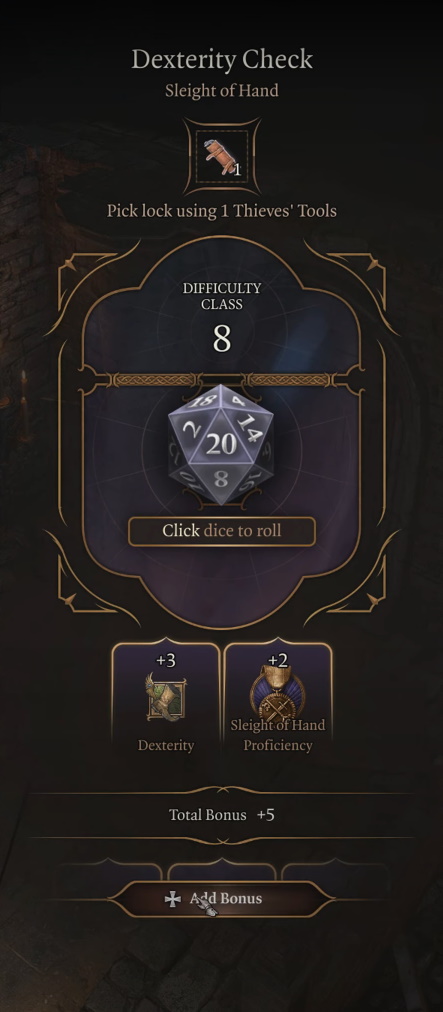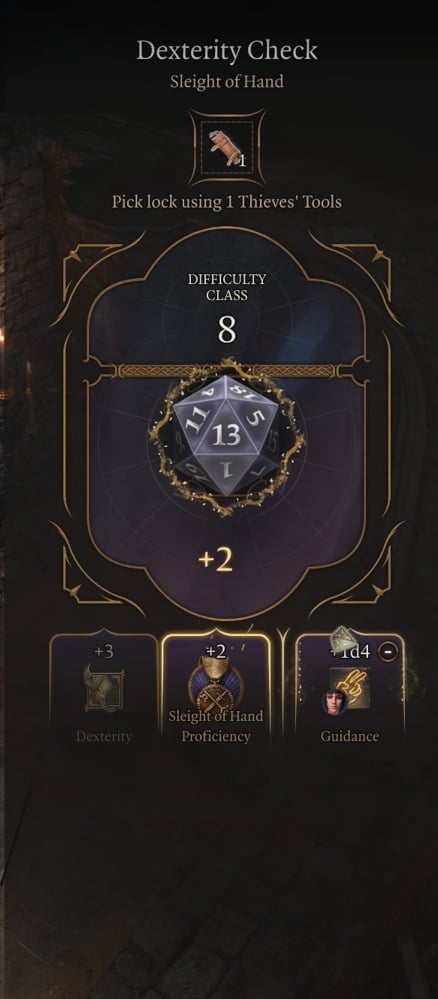D20 or 20 Sided Die is a core mechanic in Baldur's Gate 3. Baldur's Gate 3 is based on the 5th edition of Dungeons and Dragons and uses a system that involves the rolling of a 20-sided die. This die is called the d20 to resolve encounters and scenarios on the game world. In Baldur's Gate 3, this is done behind the scenes by the game, but you can see the results of the dice rolls on the bottom corner of the screen.
D20 in Baldur's Gate 3
In cases where the outcome of an action is uncertain, the D&D game relies on rolls of a 20-sided die, a d20, to determine success or failure.
Every character and monster in the game has capabilities defined by six ability scores. The abilities are Strength, Dexterity, Constitution, Intelligence, Wisdom, and Charisma, and they typically range from 3 to 18 for most adventurers. (Monsters might have scores as low as 1 or as high as 30.) These ability scores, and the ability modifiers derived from them, are the basis for almost every d20 roll that a player makes on a character’s or monster’s behalf.
The target number for an ability check or a saving throw is called a Difficulty Class (DC). The target number for an attack roll is called an Armor Class (AC)
Whenever a number is divide in the game, it gets rounded down if you end up with a fraction, even if the fraction is one-half or greater.
This simple rule governs the resolution of most tasks in Baldur's Gate 3.
How the D20 Works
- Roll the die and add a modifier: The game will roll a d20 and add the relevant modifier. This is typically the modifier derived from one of the six Ability Scores, and it sometimes includes a Proficiency bonus to reflect a character’s particular skill.
- Apply circumstantial bonuses and penalties: A Class Feature, a Spell, a particular circumstance, or some other effect might give a bonus or penalty to the check
- Compare the total to a target number: If the total equals or exceeds the target number, the ability check, Attack Roll, or Saving Throw is a success. Otherwise, it’s a failure. The game determines target numbers and tells players whether their ability checks, attack rolls, and saving throws succeed or fail.
- How to influence dice Rolls: You are also able to influence its outcome. To increase the chances of surpassing a check, you can manually add your or your Companions’ Spells to your throw. But remember that you’ll make use of Spell Slots when you cast a Spell, so choose wisely. This bonus will be added to the ones you already have (be it for any Proficiency or Abilities), and the total sum will be added to your roll
Example
In the following example, your character is attempting a Dexterity Check using 1 Thieves' Tools to open a door. In order to open it, you need to at least draw an 8 on the D20. Because of the Dexterity bonus and the Sleight of Hand Bonus, the final throw will receive a +5 by those bonuses. But as you can see on the second image, by clicking the add bonus, the player added Shadowheart's Guidance that will grant +![]() 1d4 to the final throw.
1d4 to the final throw.
In the final picture, you can see the D20 showing a 13 and the Dexterity Bonus darker than the other two, meaning that its bonus has already been granted to the D20. The +2 you see over the Sleight of Hand Proficiency is its bonus, and Shadowheart's Guidance ![]() 1d4 has yet to be rolled to add to the final formula. This means that at least you get +5 confirmed from bonus and the result of a
1d4 has yet to be rolled to add to the final formula. This means that at least you get +5 confirmed from bonus and the result of a ![]() 1d4 roll added to that.
1d4 roll added to that.



